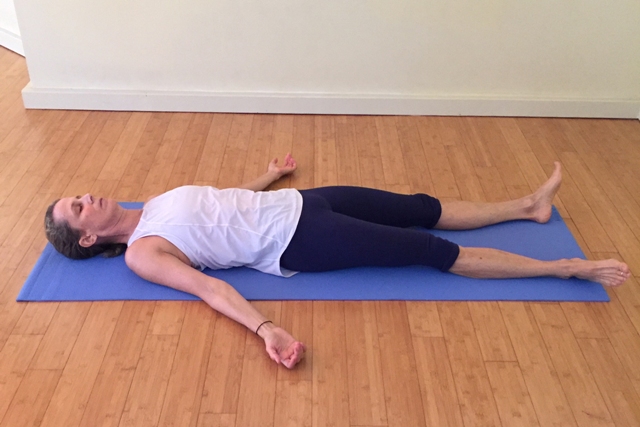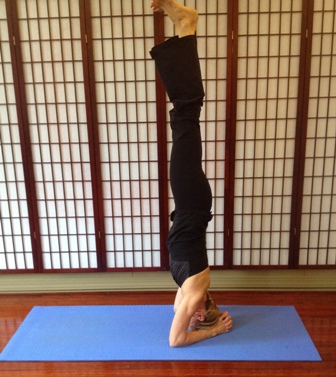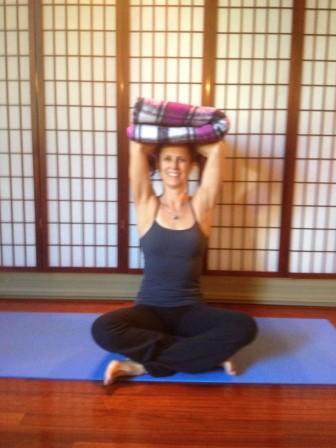The pose of the month for December is Savasana. That does not mean that we will spend the entire class in Savasana. Just like every other pose of the month, we will spend maybe 10 or 15 minutes working on the featured pose. (And, if you are lucky, you will get a lovely Savasana assist by yours truly!)
So what do we need to work on in Savasana? Aren’t we just supposed to relax and do nothing? Absolutely, but how many of us can do so? I know many students who cannot stay for Savasana. They don’t see the value in “doing nothing”.
But relaxation is so important, it breaks the stress cycle. We all know how stress is bad for our body and immune system. (You can read about how harmful stress is for your body here.) While we cannot avoid stress in our lives, we can take steps to promote relaxation and Savasana is one of those ways.
We live in a high stress society. I am amazed at how many people cannot relax.
All during class I am cueing, cajoling and encouraging my students to engage this, or straighten that, or hug towards the midline, or extend out. When we finally get to the end, it is time to relax and let go. Often a strong and sweaty practice is conducive to letting go. But, I am surprised at how much tension some students can still be holding onto in their bodies during Savasana.
Sometimes during final relaxation, I will go around and adjust a few people. I usually let people know I will be doing this so I don’t startle anyone (and I allow people to opt out). I approach them quietly and touch them gently before lifting their arm up and slowly wiggling it. If they are relaxed, the arm should move like the empty sleeve of a jacket. But more often than not, the arm comes up rigidly and the person moves the arm with me, anticipating which way I am going to wiggle it. Some students are unconsciously helping me, even though I tell them I don’t want them to help. It is not unusual for the arm to stay up in the air even after I have let go of it. When I quietly tell the person that if they were relaxed, the arm would not stay up in the air by itself, they often smile and let the arm down. Then I begin again. I ask students to “let go”, to “play dead”, “relax”. Some people simply cannot do it right away. It takes practice. We are so used to being on guard, to protecting ourselves from being taken advantage of, of not allowing ourselves to be vulnerable. The result is that we cannot let go.
I discovered what I need to do is to prepare people for relaxation; to tell them at the beginning of class what they need to do at the end, to describe what I see and feel in people’s bodies when they are tense. This seems to help a lot. In a society that values doing over being, we need instructions on how to relax.
Here are some tips on how to relax:
Plan a place and time to relax (if this is done outside of your regular yoga class.) Showing up is 80% of the work!
Determine the amount of time you have to relax and set a timer. It is easier to relax when you know how much time you are willing to give.
Make yourself comfortable. You should be lying down on the floor. Place a blanket under you if the floor is hard and you are not on carpet. Use blankets, bolsters or pillows to support your body in away way to insure you stay comfortable.
Make sure you are warm. As you lay still you will feel cooler than when you were moving, particularly if you were sweaty. Put on an extra shirt, socks or even cover yourself with a blanket.
Use an eye pillow, if you like, or cover your eyes with something like the sleeve of a shirt or a hand towel. This does two things for you: First, it creates darkness which is more conducive to relaxing. Second, it weighs the eyes down and helps to keep them from moving around. (You don’t need something heavy on the eyes, just a gentle suggestion of weight.) Eye movement stimulates the brain and we want the brain to slow down as part of the process of relaxing.
Commit to stillness. Sometimes when I lay down for Savasana I may feel as if I am too fidgety to relax and all of a sudden I have these itches and twitches and urges to move. 90% of the time, if I ignore these urges, they will go away. It seems that they are the mind’s resistance to staying still. The mind wants to be stimulated. If I am able to resist movement I begin to relax. Now, 10% of the time, you may actually have to scratch that itch, move your leg or grab another pillow. You have to use common sense here, but don’t be fooled by your restless, monkey mind or you will never be able to relax.
If you don't have the time or inclination to relax at home make sure you come to class during the month of December to work on it. You’ll be glad you did!
Come on! I know what you really come to class for:
I’ll see you in class!
Karin











